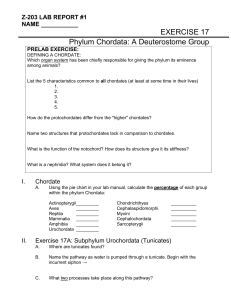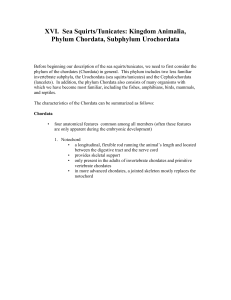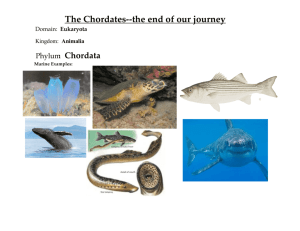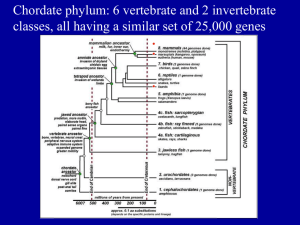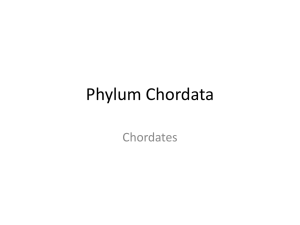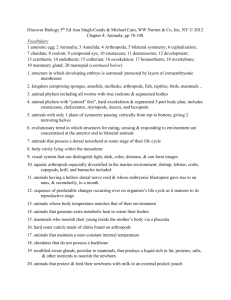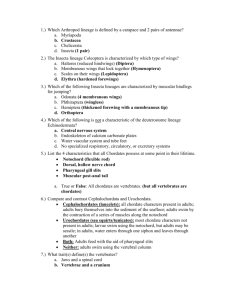Phylum Chordata: Protochordates
advertisement
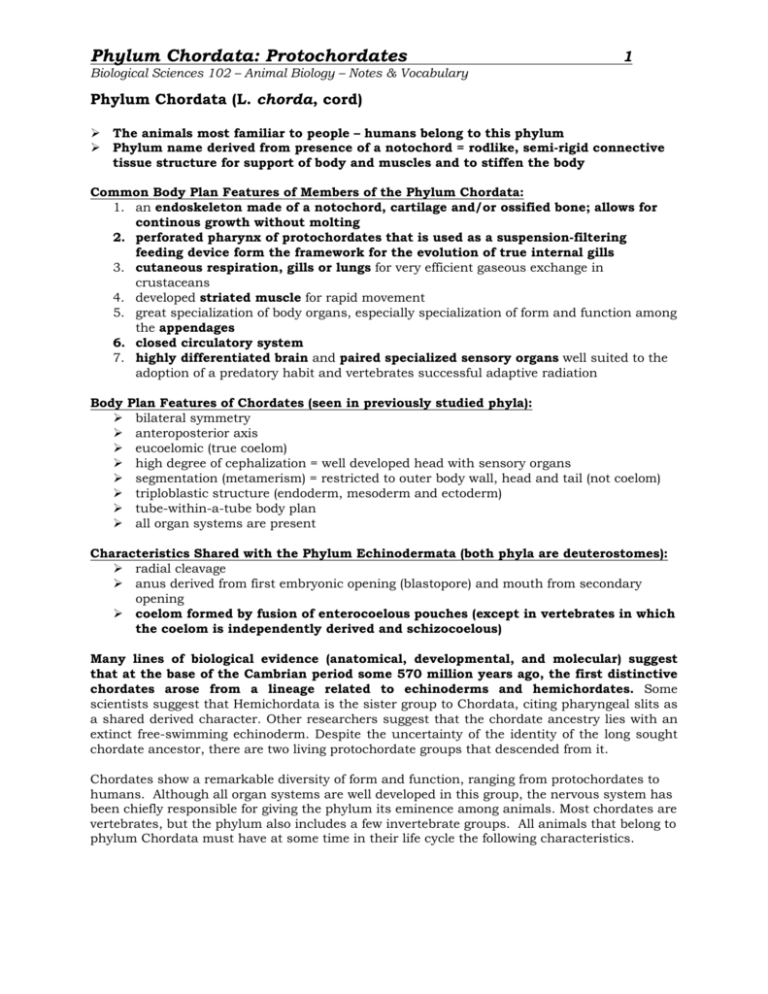
Phylum Chordata: Protochordates 1 Biological Sciences 102 – Animal Biology – Notes & Vocabulary Phylum Chordata (L. chorda, cord) ¾ ¾ The animals most familiar to people – humans belong to this phylum Phylum name derived from presence of a notochord = rodlike, semi-rigid connective tissue structure for support of body and muscles and to stiffen the body Common Body Plan Features of Members of the Phylum Chordata: 1. an endoskeleton made of a notochord, cartilage and/or ossified bone; allows for continous growth without molting 2. perforated pharynx of protochordates that is used as a suspension-filtering feeding device form the framework for the evolution of true internal gills 3. cutaneous respiration, gills or lungs for very efficient gaseous exchange in crustaceans 4. developed striated muscle for rapid movement 5. great specialization of body organs, especially specialization of form and function among the appendages 6. closed circulatory system 7. highly differentiated brain and paired specialized sensory organs well suited to the adoption of a predatory habit and vertebrates successful adaptive radiation Body ¾ ¾ ¾ ¾ ¾ ¾ ¾ ¾ Plan Features of Chordates (seen in previously studied phyla): bilateral symmetry anteroposterior axis eucoelomic (true coelom) high degree of cephalization = well developed head with sensory organs segmentation (metamerism) = restricted to outer body wall, head and tail (not coelom) triploblastic structure (endoderm, mesoderm and ectoderm) tube-within-a-tube body plan all organ systems are present Characteristics Shared with the Phylum Echinodermata (both phyla are deuterostomes): ¾ radial cleavage ¾ anus derived from first embryonic opening (blastopore) and mouth from secondary opening ¾ coelom formed by fusion of enterocoelous pouches (except in vertebrates in which the coelom is independently derived and schizocoelous) Many lines of biological evidence (anatomical, developmental, and molecular) suggest that at the base of the Cambrian period some 570 million years ago, the first distinctive chordates arose from a lineage related to echinoderms and hemichordates. Some scientists suggest that Hemichordata is the sister group to Chordata, citing pharyngeal slits as a shared derived character. Other researchers suggest that the chordate ancestry lies with an extinct free-swimming echinoderm. Despite the uncertainty of the identity of the long sought chordate ancestor, there are two living protochordate groups that descended from it. Chordates show a remarkable diversity of form and function, ranging from protochordates to humans. Although all organ systems are well developed in this group, the nervous system has been chiefly responsible for giving the phylum its eminence among animals. Most chordates are vertebrates, but the phylum also includes a few invertebrate groups. All animals that belong to phylum Chordata must have at some time in their life cycle the following characteristics. Phylum Chordata: Protochordates 2 Biological Sciences 102 – Animal Biology – Notes & Vocabulary Characteristics Specific to the Phylum Chordata 1. Notochord. The notochord (Gr. naton, back, + chorda, cord) is a slender rod of cartilage-like connective tissue lying near the dorsal side and extending most of the length of the animal. It is regarded as an early endoskeleton and has the functions of such. In most vertebrates, it is found only in the embryo. 2. Pharyngeal pouches and slits. The pharyngeal pouches and slits (gill slits) are a series of paired slits in the pharynx, serving as passageways for water to the gills. In some vertebrates, they appear only in the embryonic stages. 3. Dorsal tubular nerve cord. A dorsal tubular nerve cord, with its modification, the brain, forms the central nervous system. It lies dorsal to the alimentary tract and has a fluid-filled cavity, in contrast to the invertebrate nerve cord, which is ventral and solid. 4. Endostyle or thyroid gland. The endostyle or its derivative, the thyroid gland, is found in all chordates, but in no other animals. The endostyle secretes mucus and traps small food particles for protochordates and lamprey larvae. Some cells in the endostyle are homologous with cells of the thyroid gland found in the remainder of vertebrates. 5. Postanal tail. A postanal tail projects beyond the anus at some stage and serves as a means of propulsion in water. It mayor may not persist in the adult. Along with body muscles and stiffened notochord, it provides motility for a free-swimming existence. These features vary in chordates. Some ancestral chordates have all of these structures throughout life. In many chordates, the pharyngeal slits never break through from the pharynx but merely form pouches that have no function, the notochord is replaced by the vertebral column, and only the dorsal nerve cord actually persists in the adult as a diagnostic chordate character. Protochordates demonstrate each of the chief chordate characteristics at some point in their life cycle. Classification Phylum Chordata Subphylum Urochordata (u'ro-kor-da'ta) (Gr. oura, tail, + L. chorda, cord). (Tunicata). About 2000 species. Tunicates. Only larval forms have all chordate characteristics; adults sessile, without notochord and dorsal nerve cord; body enclosed in tunic. Example: Molgula, a sea squirt. Subphylum Cephalochordata (sef'a-Io-kor-da'ta) (Gr. kephalE, head, + L. chorda, cord). About 22 species. Lancelet. Notochord and nerve cord persist throughout life; lance-shaped. Example: Branchiostoma (amphioxus). Subphylum Vertebrata (ver'te-bra'ta) (L. vertebratus, backboned). (Craniata). About 50, 900 species. Vertebrates. Enlarged brain enclosed in cranium; nerve cord surrounded by bony or cartilaginous vertebrae; notochord in all embryonic stages and persists in adults of some fishes; typical structures include two pairs of appendages and body plan of head, trunk, and postanal tail. Phylum Chordata: Protochordates 3 Biological Sciences 102 – Animal Biology – Notes & Vocabulary Subphylum Urochordata (tunicates/sea squirts = about 2000 species) The Subphylum Urochordata is divided into three classes: ¾ Class Ascidiace(Gr. askiolion, little bag, + acea, suffix) = most common and diverse ¾ Class Larvacea (L. larva, ghost + acea, suffix) ¾ Class Thaliacea (Gr. thalia, luxuriance, acea suffix) ¾ ¾ ¾ ¾ found in all seas from near shoreline to great depths among the most abundant of intertidal animals. most are sessile as adults, although some are free living the name "tunicate" due to tough, nonliving tunic, or test, around the animal that contains cellulose Ascidian Tunicates ¾ ¾ ¾ ¾ ¾ ¾ ¾ ¾ ¾ Ascidians may be solitary, colonial (have own test), or compound (share a test with other individuals) solitary ascidians usually spherical or cylindrical mantle lines inner tunic incurrent or oral (anterior) and excurrent or atrial (dorsal) siphons project to outside water enters the incurrent siphon into the pharynx that is divided by gill slits to form a basket-like net larval forms resemble a microscopic tadpole that bears all chordate hallmarks During adult metamorphosis, the notocord (which, in the larva, is restricted to the tail, hence the name Urochordata) and tail disappear, while the dorsal nerve cord becomes reduced to a single ganglion of the five chief characteristics of chordates, adult sea squirts have only two: pharyngeal slits and endostyle the larval form reveals the secret of their true relationship; the tadpole larva is an elongate, transparent form with all five chordate characteristics: notochord, hollow dorsal nerve cord, propulsive postanal tail, and a large pharynx with endostyle and pharyngeal slits; the larva does not feed but swims for some hours before fastening itself vertically by adhesive papillae to a solid object; it then undergoes a dramatic metamorphosis to become a sessile adult, so modified as to become almost unrecognizable as a chordate ¾ feeding depends on formation of a mucous net that is secreted by a glandular groove, the endostyle, located along the midventral side of the pharynx; cilia on gill bars of the pharynx pull the mucus into a sheet that spreads dorsally across the inner race of the pharynx; food particles brought in the incurrent opening are trapped on the mucous net, which is then worked into a rope and carried posteriorly by cilia into the esophagus and stomach; nutrients are absorbed in the midgut and indigestible wastes are discharged from the anus, located near the excurrent siphon; the terminal part of the gut referred to as the intestine actually is not homologous with the intestine of other chordates, but rather with the hepatic cecum of amphioxus. ¾ the circulatory system consists of a ventral heart and two large vessels, one on either side of the heart; these vessels connect to a diffuse system of smaller vessels and spaces serving the pharyngeal basket (where respiratory exchange occurs) the heart drives the blood first in one direction for a few beats, then pauses, reverses its action, and drives the blood in the opposite direction for a few beats (no other chordate heart does this) high amounts of rare elements in the blood, such as vanadium and niobium. ¾ ¾ Phylum Chordata: Protochordates 4 Biological Sciences 102 – Animal Biology – Notes & Vocabulary ¾ the nervous system is restricted to a nerve ganglion and plexus of nerves that lie on the dorsal side of the pharynx ¾ sea squirts are hermaphroditic, with usually a single ovary and a single testis in the same animal. ¾ germ cells (gametes) are carried by ducts into the atrial cavity, and then into the surrounding water where fertilization occurs Thaliacean tunicates ¾ ¾ ¾ ¾ tunicates of the Class Thaliacea, known as thaliaceans or salps, are barrel- or lemonshaped pelagic forms with transparent, gelatinous bodies that, despite the considerable size that some species reach, are nearly invisible in sunlit surface waters they occur singly or in colonial chains that may reach several meters in length the cylindrical thaliacean body is typically surrounded by bands of circular muscle, with incurrent and excurrent siphons at opposite ends; water pumped through the body by muscular contraction (rather than by cilia as in ascidians) is used for locomotion by a sort of jet propulsion, for respiration, and as a source of particulate food that is filtered on mucous surfaces; many are provided with luminous organs, which give a brilliant light at night; most of the body is hollow, with the viscera forming a compact mass on the ventral side the life histories of thaliaceans are often complex and are adapted to respond to sudden increases in their food supply; the appearance of a phytoplankton bloom, for example, is met by an explosive population increase leading to extremely high density of thaliaceans; common forms include Doliolum and Salpa, both of which reproduce by an alternation of sexual and asexual generations. Larvacean tunicates ¾ ¾ ¾ ¾ tunicates of the Class Larvacea (Appendicularia in some classifications) are larva-like pelagic creatures shaped like a bent tadpole; their resemblance to the larval stages of other tunicates has given them their class name of Larvacea. they feed by a method unique in the animal world - each builds a delicate house, a transparent hollow sphere of mucus interlaced with filters and passages through which water enters; particulate food trapped on a feeding filter inside the house is drawn into the animal's mouth through a strawlike tube; when the filters become clogged with waste, which happens about every 4 hours, the larvacean abandons its house and builds a new house, a process that takes only a few minutes like thaliaceans, larvaceans can quickly build up dense populations when food is abundant larvaceans are paedomorphic; they are sexually mature animals that have retained the larval body form of their evolutionary ancestors. Subphylum Cephalochordata (lancelets; Branchiostoma/Amphioxus) ¾ ¾ ¾ ¾ ¾ cephalochordates are lancelets: slender, laterally compressed, translucent animals about 5 to 7 cm in length inhabit the sandy bottoms of coastal waters around the world lancelets originally bore the generic name Amphioxus (Gr. amphi, both ends, + oxys, sharp), later surrendered by priority to Bran. chiostoma (Gr. branchia, gills, + stoma, mouth). Amphioxus is still used, however, as a convenient common name for all of approximately 25 species four species of amphioxus occur in North American coastal waters Amphioxus is especially interesting because it has the five distinctive characteristics of chordates in simple form Phylum Chordata: Protochordates 5 Biological Sciences 102 – Animal Biology – Notes & Vocabulary ¾ water enters the mouth, driven by cilia in the buccal cavity, then passes through numerous pharyngeal slits where food is trapped in mucus, which is then moved by cilia into the intestine; here the smallest food particles are separated from the mucus and passed into the hepatic cecum where they are phagocytized and digested intracellularly; as in tunicates, filtered water passes first into an atrium, then leaves the body by an atriopore (equivalent to the excurrent siphon of tunicates). ¾ the closed circulatory system is complex for so simple a chordate; flow pattern is remarkably similar to that of primitive fishes, although there is no heart; blood is pumped forward in the ventral aorta by peristaltic-like contractions of the vessel wall, then passes upward through branchial arteries (aortic larches) in the pharyngeal bars to paired dorsal aortas which join to become a single dorsal aorta; from here blood is distributed to body tissues by microcirculation and then is collected in veins, which return it to the ventral aorta; lacking both erythrocytes and hemoglobin, their blood is thought to transport nutrients but play little role in gas exchange ¾ the nervous system is centered around a hollow nerve cord lying above the notochord; pairs of spinal nerve roots emerge at each trunk myomeric (muscle) segment sense organs are simple, unpaired bipolar receptors located in various parts of the body the "brain" is a simple vesicle at the anterior end of the nerve cord. dioecious; gametes are set free in the atrial cavity, then pass out the atriopore to the outside where fertilization occurs cleavage is total (holoblastic) and a gastrula is formed by invagination larvae hatch soon after egg deposition and gradually assume the shape of adults no other chordate shows the basic diagnostic chordate characteristics as clearly as amphioxus in addition to the five chordate anatomical hallmarks, amphioxus possesses several structural features that suggest the vertebrate plan; among these are a hepatic cecum, a diverticulum that resembles the vertebrate pancreas in secreting digestive enzymes, segmented trunk musculature, and the basic circulatory plan of more advanced chordates ¾ ¾ ¾ ¾ ¾ ¾ ¾ Subphylum Vertebrate or Craniata (vertebrates) ¾ ¾ ¾ the third subphylum of chordates is the large and diverse Subphylum Vertebrata this monophyletic group shares the basic chordate characteristics with the other two subphyla the alternative name of the subphylum, Craniata, more accurately describes the group since all have a cranium (bony or cartilaginous braincase) but some jawless fishes lack vertebrae The earliest vertebrates were substantially larger and considerably more active than the protochordates. Increased speed and mobility resulted from modifications of the skeleton and muscles. The higher activity level and size of vertebrates also requires structures specialized in the location, capture, and digestion of food and adaptations designed to support a high metabolic rate. Phylum Chordata: Protochordates 6 Biological Sciences 102 – Animal Biology – Notes & Vocabulary More on Animal Development – Terms Relevant to Classification blastomere = an early cleavage cell in a developing embryo Cleavage = early embryonic cell divisions (mitosis) determinate cleavage = the type of cleavage, usually spiral, in which the fate of the blastomeres is determined very early in development; mosaic cleavage mosaic cleavage = embryonic development characterized by independent differentiation of each part of the embryo indeterminate cleavage/development = the type of embryonic development in which the fate of blastomeres is not determined very early as to tissues or organs (cell differentiation); regulative cleavage regulative cleavage/development = embryonic development determined by interactions among neighboring cells; cell fates are not fixed early in development Coelom Formation schizocoelic coelom and mesoderm formation = formation of a coelom by splitting of the embryonic mesoderm; embryonic formation of the mesoderm as cords of cells between ectoderm and endoderm; splitting of these cords results in the coelomic space enterocoelic coelom and mesoderm formation = formation of a coelom by outpouching of the mesodermal sac from the endoderm of the primitive gut; embryonic formation of the mesoderm by a pouchlike outfolding from the archenteron, which then expands and obliterates the blastocoel, thus forming a large cavity, the coelom, lined with mesoderm archenteron = the main cavity of an embryo in the gastrula stage; it is lined with endoderm and represents the future digestive cavity Protostomia A group of phyla in which cleavage is determinate, the coelom (in coelmate forms) is formed by proliferation of mesodermal bands (schizocoelic formation), the mesoderm is formed from a particular blastomere (called 4d) and the mouth is derived from or near the blastopore; includes the phyla Annelida, Mollusca, Arthropoda and a number of minor phyla. Blastopore becomes the mouth. Ecdysozoan Protostomes Any member of a clade within Protostomia whose members shed the cuticle as they grow; includes the phyla Arthropoda, Nematoda and several smaller phyla. Lophotrochozoan Protostomes Any member of a clade within Protostomia whose members generally possess either a trochophore larva or a lophophore; includes the phyla Annelida, Mollusca and the ectoprocts trochophore larvae = a free-swimming ciliated marine larva characteristic of most molluscs and certain ectoprocts, brachiopods, and marine worms; an ovoid or pyriform body with preoral circlet of cilia and sometimes a secondary circlet behind the mouth. Phylum Chordata: Protochordates 7 Biological Sciences 102 – Animal Biology – Notes & Vocabulary lophophore = tentacle-bearing ridge or arm within which is an extension of the coelomic cavity in lophophorate animals. ectoproct = bryozoans (moss animals); psuedocoelomate animals that have their anus located within a crown of tentacles; about 4500 species; both freshwater and marine; few more than 0.5 mm long Deuterostomia A group of phyla in which cleavage is indeterminate (regulative) and primitively radial. The mesoderm arises by enterocoelic formation, and the mouth is derived away from the blastopore; includes the phyla Echinodermata, Chordata and Hemichordata. Blastopore becomes the anus.
